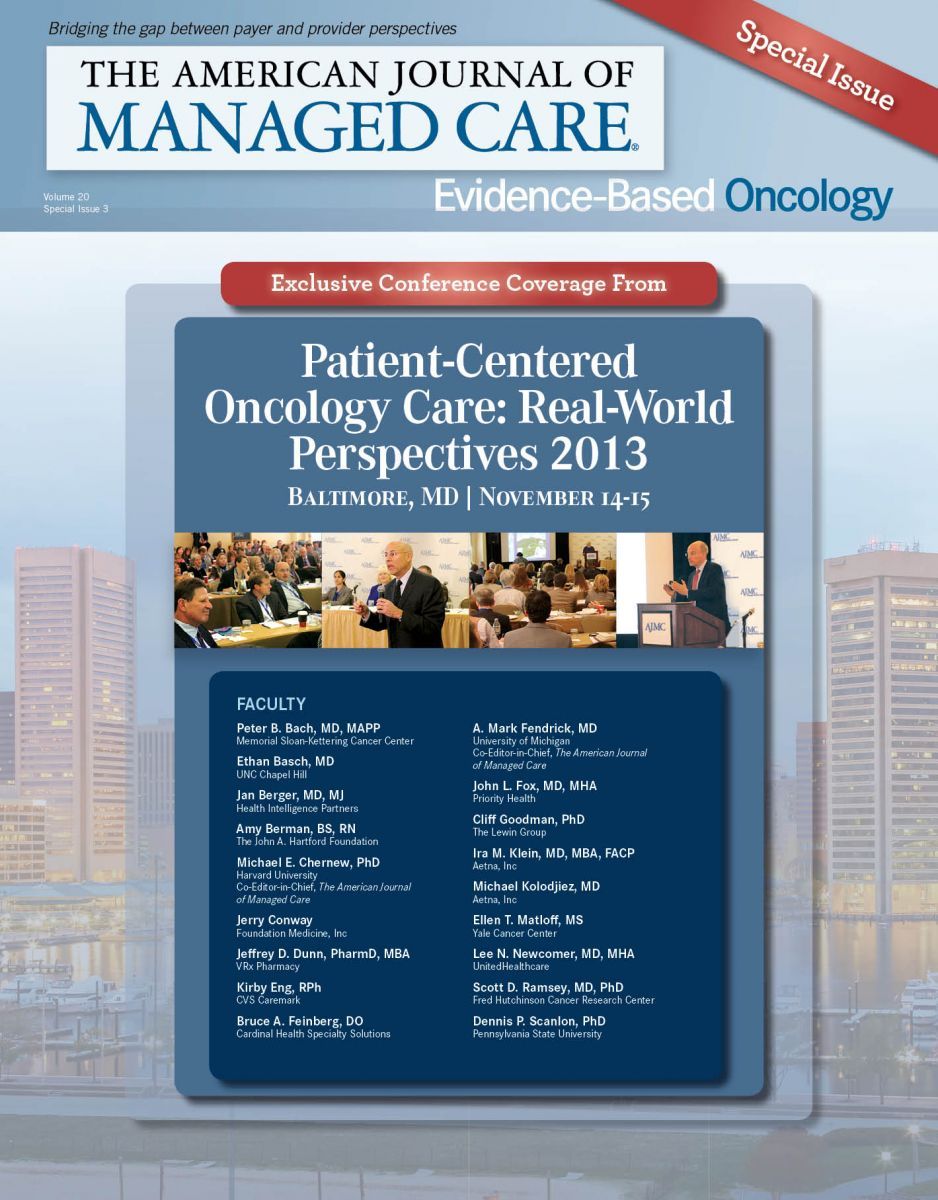Publication
Article
Evidence-Based Oncology
Can Clinical Pathways Change the 'Culture' in Cancer Care?
Author(s):
Bruce A. Feinberg, DO, of Cardinal Health Specialty Solutions, published results in Evidence-Based Oncology1 showing that Cardinal's deployment of pathways had achieved measurable savings across a diverse set of healthcare providers, with an actuary's validation.
In May 2013, Bruce A. Feinberg, DO, of Cardinal Health Specialty Solutions, published results in Evidence-Based Oncology1 showing that Cardinal’s deployment of pathways had achieved measurable savings across a diverse set of healthcare providers, with an actuary’s validation. In his talk, “An Update on Clinical Pathways,” Feinberg outlined the Cardinal philosophy, while raising an important issue: educating doctors about better quality approaches will not change behavior until they are aligned with financial incentives.
The crisis in cancer care delivery is clear: an aging population, combined with treatment advances, will create ever-rising numbers of survivors, and, with them, rising costs. Bruce A. Feinberg, DO, referred to wellknown statistics: the number of cancer survivors will rise 30% by 2022, and cancer incidence will rise 45% by 2030. Costs of cancer care, which were $125 billion in 2010, are expected to rise 39% to $173 billion by 2020.2
How can oncology address “increasing innovation and increasing cost at a time of increasing incidence”?
One answer is clinical pathways, which offer a narrower range of evidence- based options from among accepted treatment choices. Feinberg said that while pathways companies may look similar from afar, this is not the case. What sets Cardinal apart, he said, “is that we have validated savings against multiple cancers.”
He referenced results published in May 2013,1 which showed that Cardinal’s pathways pilot with CareFirst BlueCross BlueShield, for treatment of breast, lung, and colon cancers, resulted in lower rates of emergency department visits, lower rates of hospitalization, and a 7% overall decline in hospital admissions. “There was a 15% savings to the health plan, and the doctors actually were reimbursed higher for participating,” he explained. Of greatest importance, Cardinal’s results received third-party validation by Milliman.
Even with this evidence, moving the cancer care community from the way things have been to the way they should be requires more than presenting facts. Feinberg went through several examples in which physicians have had evidence but still failed to pursue less costly, less intrusive options, especially in end-of-life care.
He pointed to the 2012 study in Health Affairs,3 led by Nancy E. Morden, MD, of The Dartmouth Institute, which found an alarming intensity in end-oflife care among cancer patients whose prognosis was known to be poor; worse, this intensity of care cut across all types of settings, including leading cancer centers. More recent data are not encouraging. Feinberg noted that the Dartmouth Atlas had just reported that while hospital deaths declined 14.4%, this came as the result of a 31% increase in patients with a hospice stay of 3 days or less. This, he said, is not good news.
“I will tell you, as someone who did oncology patient care for 25 plus years, there is nothing worse you can do to a patient or a family than when they are in the active process of dying, take them or their family and move them out of that hospital bed and move them somewhere else so they can die a day later.”
Avoiding this scenario, producing better results and savings starts with engagement. The greatest challenge, Feinberg said, is gaining physician buyin, and taking on what he called the “culture of medicine.”
“If we don’t’ get to the culture of medicine, then we’re really ignoring the elephant in the room,” Feinberg said. “It’s a culture of medicine which embraces now over later, new over old, and more over less.”
He distilled the principles of change espoused by quality care advocates:
• Pay for value, not for volume.
• Ensure physician core competencies in evidence-based medicine.
• Promote patient-centered care, in which the patient is fully informed and involved in shared decision making.
• Deploy health information technology (HIT) with real-time analyses that enable the other goals.
Evidence shows that this approach works. He discussed results from the New England Journal of Medicine which show that early use of palliative care produces better survival rates than standard care.4
Echoing Berman’s keynote message, Feinberg said longer and better survival requires a better understanding of the patient’s prognosis and goals, less intravenous chemotherapy in the last 60 days of life, less aggressive end-oflife care, and more and earlier use of hospice care.
How can the culture be changed? Feinberg offered the following:
First, pathway compliance should be focused on the 20% of diagnoses that are responsible for 80% of the costs. Second, reform efforts should be targeted on those behaviors with the greatest impact on cost and quality.
EBO
Physicians must be engaged intensively, he said, “but choose your battles wisely.” Patients need to be educated, too. Finally, accountability demands HIT solutions for both physicians and patients that will promote these goals while being HIPAA complaint. When it comes to getting physicians to honestly present end-of-life options, payers and practice leaders must ask, “Do they know how to have the conversation?”
1. Feinberg BA, Milligan S, Cooper J, et al. Thirdparty validation of observed savings from an oncology pathways program. Am J Manag Care. 2013;19(SP4):SP127,SP153-SP157.
2. Smith TJ, Hillner BE. Bending the cost curve in cancer care. N Engl J Med. 2011;364(21): 2060-2065.
3. Morden NE, Chang CH, Jacobson JO, et al. End-of-life care for Medicare beneficiaries is highly intensive overall and varies widely. Health Aff. 2012;31(4):786-796.
4. Temel JS, Greer JA, Muzikansky A, et al. Early palliative care for patients with metastatic nonsmall- cell lung cancer. N Engl J Med. 2010;363 (8):733-742.


